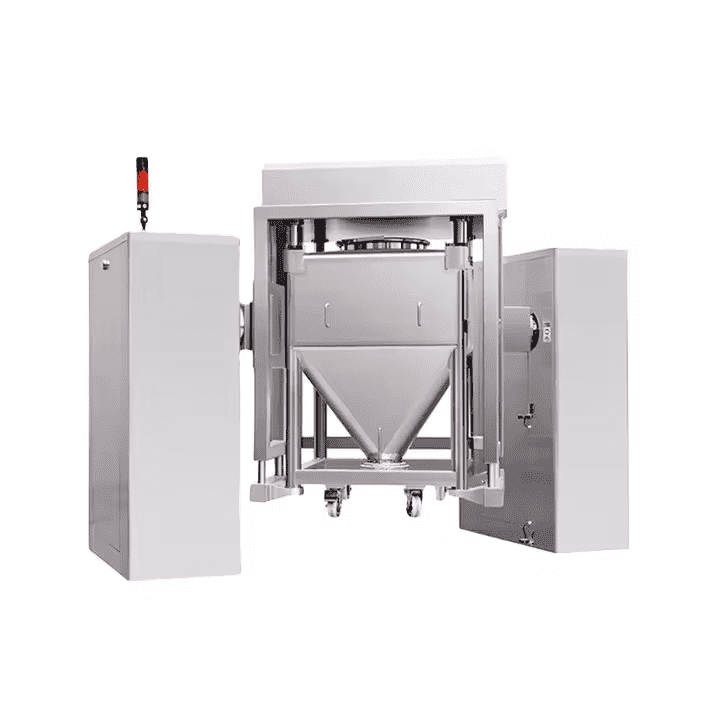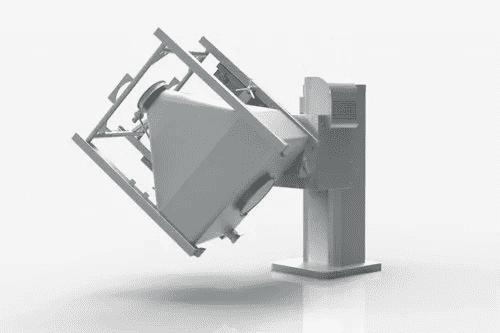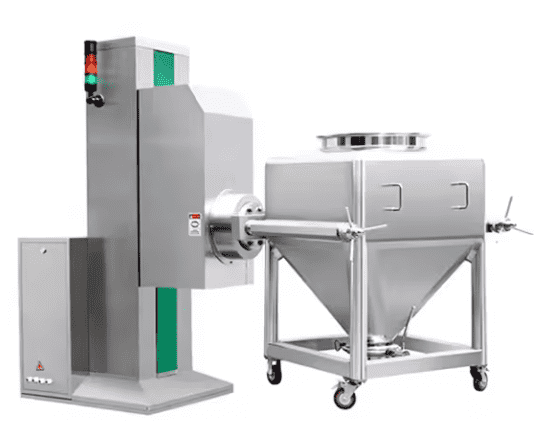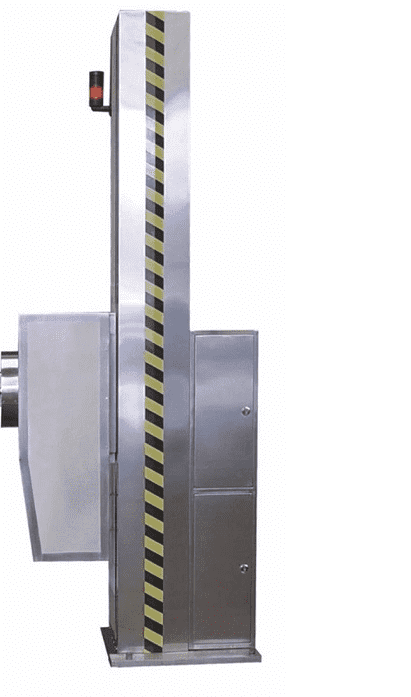Explore Bin Blenders: How They Work and How to Choose
In the pharmaceutical industry, it is important to make sure that medicine ingredients are mixed evenly. Because this is highly related to the quality and effectiveness of the medicine. So it is crucial to choose the right mixing equipment for your business. Among the many types of mixing machines, the bin blender has become more popular.
What is a Bin Blender?

A bin blender is also called an IBC (Intermediate Bulk Container) blender. It is designed for blending powders, granules, and other solid materials. It typically consists of a detachable mixing bin and a fixed rotating mechanism. It allows the mixing bin can be easily removed. So this is easy for changeovers between different batches.
Meanwhile, the mixing bin is tightly attached to the rotating mechanism. It provides the necessary motion to achieve thorough and uniform mixing. Many bin blenders also come with advanced control systems. They allow operators to set specific mixing parameters, such as speed, rotational direction, etc.
Bin blenders are particularly valued for high flexibility. They can handle batch sizes from small laboratory-scale to large industrial quantities. And you just need to change the size of the mixing bin. In addition, when you use a bin blender, there is less risk of cross-contamination between batches. Because the mixing bins can be easily removed and cleaned or replaced. This is particularly important in the pharmaceutical and food industries.
Applications
Bin blenders are used in many industries for mixing materials. It is mainly used in the pharmaceutical industry. They mix active ingredients and excipients to ensure uniform dosage. In the food industry, they are always used to mix spices and additives. It helps maintain consistent flavor and texture. Besides, bin blenders are applied in the chemical industry. They mix powders and granules to ensure consistent chemical properties.
Five Key Components of Bin Blenders
Mixing Bin

The mixing bin or container is a crucial part of the bin blender. Its shape is often conical or cylindrical. The material will be put inside and mixed thoroughly. This part also can complete the discharge of materials after mixing. There is a lid on the bin which seals tightly. It can prevent leakage and contamination during mixing.
The bin's design features smooth, polished surfaces to minimize material sticking. It comes in various sizes. If you have specific production needs, customization is also available.
Rotating Mechanism

The rotating mechanism powers the mixing process. It includes a motor and a drive system. There are different sizes and weights of bins. So they also require various amounts of power. The drive system mainly consists of gears and belts. They work together to transmit the motor's power to the bin. It ensures smooth and controlled rotation.
Some bin blenders rotate the bin around a single axis. Now there are advanced models. They offer multi-axis rotation, enhancing the mixing process. The rotation angle can often be adjusted. It allows for greater flexibility and improved mixing efficiency.
Control Panel

The control panel is part of the control system. It allows operators to control the mixing process precisely. It supports to set and adjust various parameters like rotating angles. Some models may be equipped with advanced control systems. They can store and use specific mixing recipes. It makes the whole process of standardization much easier.
To be safe, the control panel has lots of safety features. They include emergency stop buttons, overload protection, and locks. It greatly improves the safety while operating.
Supporting Frame

The supporting frame provides structural support for the bin blender. It is mainly built from stainless steel. The frame must be secure to withstand the forces generated during rotation. It always includes rubber feet or vibration dampeners. They work together to minimize vibrations and noise. It ensures a smoother and quieter mixing process.
Some bin blenders have wheels or casters for easy movement. They often include locking mechanisms to secure the mixer during operation. Larger models may be anchored to the floor for maximum stability.
Safety Shields and Guards

Safety barriers and guards cover rotating parts and other important areas. They prevent operators from accidentally touching moving parts, ensuring safe operation.
How Does a Bin Mixer Work?
Loading the Material
At first, put the ingredients like powders into the mixing bin. The bin should be filled to an appropriate level. It is usually between 50% and 80% of its total capacity. This allows for efficient mixing without overloading. Then seal the bin with a lid. It prevents spillage and contamination during the mixing process.
Securing the Bin
Then you should attach the sealed bin to the rotating part of the bin mixer. It is a key step of the whole process. The mechanism is made to hold the bin securely while it mixes. Before starting the mixing process, you must check all fixed points. It aims to make sure the bin is locked in place and not loose. This step helps prevent any accidents during mixing.
Additionally, some bin mixers let you adjust the bin's position or angle. This adjustment can improve mixing and meet the needs of different materials.
Starting the Mixing Process
Next, you need to set the desired parameters in the control panel, such as duration, direction, etc. Then the mixing device begins to rotate the bin. This rotation can occur along one or more axes. It depends on the design of the mixer.
The common movements include tumbling and rolling. Tumbling means the bin rotates end over end, while rolling means the bin rolls around its horizontal axis. Tumbling can be combined with tilting to enhance mixing.
Unloading the Material
When the mixing time is done, the mixer stops. For some models, you need to detach the bin from the mixer yourself. Some heavy bins have an automatic system. After mixing, the system unlocks the bin and releases the mixture.
After mixing is finished, you can clean the bin well to remove any leftover materials. This prevents contamination of the next batch.
2 Basic Considerations when Choosing a Bin Blender
Material Types
Bin blenders work well with free-flowing powders and granules. These materials mix evenly without sticking together. Common suitable materials include pharmaceutical powders, food ingredients, and chemical granules.
They are not suitable for sticky or abrasive materials. Sticky materials can clump together, leading to uneven mixing. Abrasive materials can wear down the blender’s surfaces and components. Both can reduce the efficiency of the blending and increase maintenance needs.
Bin Size
Each bin has an optimal fill level, typically between 50% to 80% of its capacity. So you should select a proper bin size to match your production volume needs. It can ensure that the mixer can handle the necessary volume efficiently. This alignment is critical for meeting production goals and deadlines.
The End
A right bin blender can significantly enhance production processes. As technology advances, modern bin blenders offer more sophisticated features. They further optimize mixing performance and operational efficiency. So you should have a clear understanding of their principles. Then you can make the best choice of purchasing a bin blender.
Leave your comment
Also Offers


Containment Automatic Capsule Filling Machine SFK-703

Fully Automatic Dosator Capsule Filling Machine CZ-40

Our Team
As an expert in the pharmaceutical and pharmaceutical packaging industry, iPharMachine has provided solutions for hundreds of pharmaceutical and health product manufacturers for 17 years. By visiting customers, we get good reviews from our customers.
- info@ipharmachine.com
- English Español Deutsche







